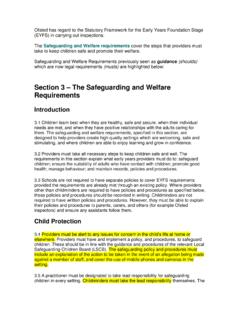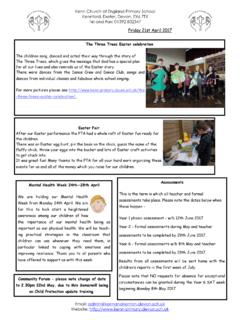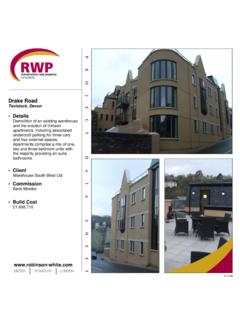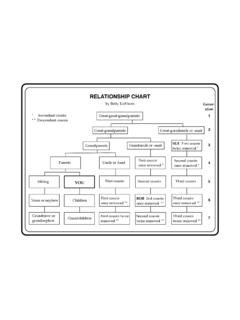Transcription of Devon Libraries Exeter Blitz
1 Devon Libraries Exeter Blitz Factsheet 17. On the night of 3rd - 4th of May 1942, Exeter suffered its most destructive air raid of the Second World War. 160 high explosive bombs and 10,000 incendiary devices were dropped on the city. The damage inflicted changed the face of the city centre forever. Exeter suffered nineteen air raids between August 1940 and May 1942. The first was on the night of 7th 8th of August 1940, when a single German bomber dropped five high explosive bombs on St. Thomas. Luckily no one was hurt and the damage was slight. The first fatalities were believed to have been in a raid on 17th September 1940, when a house in Blackboy Road was destroyed, killing four boys.
2 In most of the early raids it is likely that the city was not the intended target. The Luftwaffe flew over Exeter on its way towards the industrial cities to the north. It is possible that these earlier attacks on Exeter were caused by German bombers jettisoning unused bombs on the city when returning from raiding these industrial targets. It was not until the raids of 1942 that Exeter was to become the intended target. The town of Lubeck is a port on the Baltic; it had fine medieval architecture reflecting its wealth and importance. Although it was used to supply the German army and had munitions factories on the outskirts of the town, it was strategically unimportant.
3 The bombing of this town on the night of 28th 29th March on the orders of Bomber Command is said to be the reason why revenge attacks were carried out on some of the most beautiful towns in England'. The Baedeker raids, so called because the targets had been selected from the pre-war Baedeker tourist guide to England, moved away from bombing strategic targets and selected cities where the attacks would have the most disruptive effect on civilian life'. The cities of Bath, Norwich, York and Canterbury were targeted, but it was Exeter in the spring of 1942 that was the first to be attacked. The first raid was on the night of 23rd 24th April 1942, when seven high explosive bombs were dropped on the Okehampton Street area of St.
4 Thomas. A considerable amount of damage was done to properties in the area, and five people were killed and seventeen injured. The following night saw the city encircled with parachute flares; the illumination caused enabled the enemy planes to release 65 high explosive bombs on the town; most of which fell on the residential area of Pennsylvania, although some landed in the Paris Street, Kings Street and Wonford areas of the city. 73 people were killed and 20 people were seriously injured, with a further 53 people being slightly injured. There was also extensive damage to property. A further raid on 26th April saw just 1 high explosive bomb dropped on the city; however this was supplemented with a large number of incendiary bombs which caused extensive damage to several houses in the Portland Street area.
5 3 people were killed in this raid and 16 were injured. Although these raids had brought death and destruction to Exeter , there was worse to come. In the early morning of 4th May 1942, a large force of German Junkers fighter bombers flew up the river Exe. Their mission was finally to destroy the city after the failure of the previous raids. Flying low, they dropped their cargo of flares to illuminate the city. They then proceeded to unleash 10,000 incendiary bombs and 75. tons of high explosives. The effect was devastating and soon large parts of South Street, Fore Street, High Street, Sidwell Street, Paris Street and Southernhay were ablaze. As water mains were fractured and the large water tanks made inaccessible due to debris, the Fire Service could only watch while most of the city burned.
6 The recently built Exeter City Library was destroyed and the Cathedral was hit, but luckily survived the damage to its south side. 161 people were killed and 70 people were seriously injured, a further 406 people received minor injuries. The devastation caused to the central shopping and business areas of the city was extensive; there was also a great loss of residential housing and industrial premises. The end of the war brought about the task of rebuilding the city's commercial centre. By 1945 most of the ruined buildings had been cleared and basements filled with rubble to provide a stable foundation for the rebuilding of the city. Thomas Sharp, a professional town planner who was already engaged in post-war redevelopment, was appointed to produce plans for the redevelopment of the city.
7 These plans were displayed to the public in the burnt-out shell of the city library. It was decided that the excessive cost' of the land need to implement Sharp's plan could not be met and only a small portion of his original plan was realized. Bibliography Exeter Phoenix: a plan for rebuilding by Thomas Sharp. Published for Exeter City Council by the Architectural Press London. 1946. Exeter , the Blitz and rebirth of the city: the reconstruction of the central areas of Exeter 1945-65 by Norman Venning. 1988. ISBN 0861148304. Fire on the wind by Peter Thomas. 1992. ISBN 0951682016. Target Exeter by Geoff Worrall. 1992. The Baedeker Blitz : Hitler's attack on Britain's historic cities by Niall Rothnie.
8 1992. ISBN 0711020388. The Bombing of Exeter written and compiled by Davies. 1973. The story of the Exeter Blitz passed for publication by the Ministry of Information. This jewel remains: illustrated record of the German Baedeker raid on Exeter the Cathedral capital of the west, on May 4th, 1942 compiled by Hoare Blitz Statistics Raids causing damage: 19. Killed: 265. Seriously injured: 111. Other casualties: 677. Destroyed in May 1942 Blitz : Houses: 1,400. Other buildings: 400. Churches: 9. Damaged in the Blitz : Houses: 16,200. Other buildings: 800. Churches: 22. Using Westcountry Studies Library resources Before visiting, please ring to check the availability of stock and to book microfilm readers.
9 For a full list of holdings, and to view illustrations, see the online local studies catalogue at Westcountry Studies Library opening hours Monday Tuesday Wednesday Thursday Friday Saturday Contact details Address: Westcountry Studies Phone: 01392 384216. Library Castle Street Email: Exeter EX4 3PQ. Different formats If you would like a summary of this in a different format such as large print, Braille or tape, or in a different language, please contact our Customer Service Centre on 0845 155 1015 or email Last updated December 2009.














